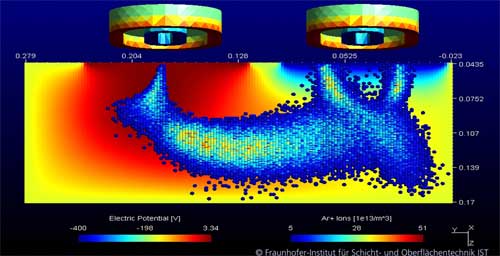| Posted: November 17, 2006 |
New software accurately calculates application of nanofilms |
|
(Nanowerk News) Sun protective films on glass deflect heat and reduce energy costs for heating and cooling. They are only a few nanometers thick and make high demands on the coating process. A new software program accurately calculates the application of thin-film systems.
|
|
A thin mist of silver, packed in oxide or nitrite, settles on the window pane like a transparent film. No more than a few nanometers thick, this layer is translucent yet capable of deflecting heat. The sun-protection nanofilm prevents rooms behind large glass facades from overheating by separating the incident sun rays into short-wave light rays and long-wave heat rays – unlike conventional thermal barrier coatings, which merely filter out and reflect the long-wave heat rays.
|
 |
| The new DOGMA software comprehensively simulates the complex processes taking place during plasma coating. (Source: Fraunhofer IST)
|
|
Nanofilms make high demands on the coating process, as Dr. Bernd Szyszka of the Fraunhofer Institute for Surface Engineering and Thin Films IST in Braunschweig confirms: “In the case of conventional thermal barrier coatings, differences of up to five per cent in the coating thickness are not a problem,” he says. “But the maximum tolerance for sun protection films is only one per cent.”
|
|
These films have already been produced on an industrial scale for several years, generally using the sputtering technique. This process takes place in a vacuum chamber, where the energetic ions of a plasma shoot atoms from a silver plate. The atoms are deposited on a passing pane of glass, and accumulate to form a wafer-thin film. Glass panes of just under 20 square meters in size can be fully coated in 45 seconds using this method. It really works – “and yet to this day, the process is still a bit like black magic, influenced by variables that are not fully understood,” says Bernd Szyszka. Consequently, it took a long series of test runs and a great deal of experience to achieve satisfying results.
|
|
Scientists at the Fraunhofer IST have now demystified the events occurring in the vacuum chamber. The new DOGMA software comprehensively simulates the complex processes taking place during plasma coating. This makes it possible to accurately calculate the application of thin-film systems, be it on large panes of glass or on thimble-sized filters for optical signal transmission. As a result, plant engineers, thin-film developers and manufacturers can optimize plants and processes not only at the planning stage, but also later on during production.
|

